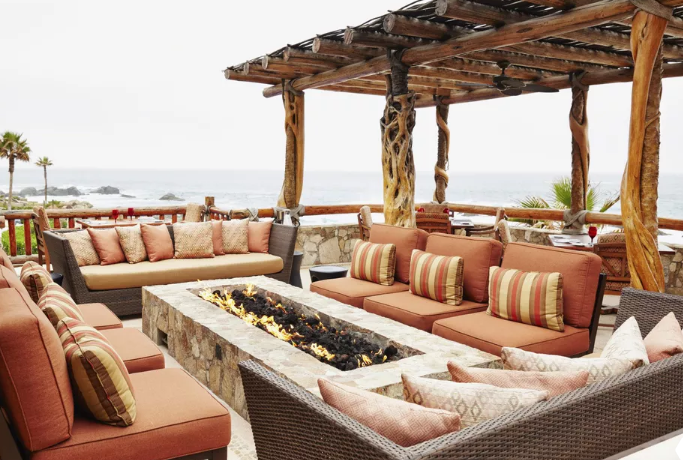Patio comes from the Spanish word patio, meaning backyard or back garden. Traditionally, it is the open inner court of a Spanish or Spanish-style house. In common usage, it is used to describe any outdoor living space often adjoining a residence, used for dining, entertaining or relaxation. Patios may or may not have covers or roofs and are usually paved areas between the house and garden. They can be made of concrete, brick, stone, flagstone, gravel, pavers,
A patio can be attached to a house or freestanding. A walled patio is often referred to as a courtyard or courtyard patio.
A Patio as an Extension of a House or Room
If thoughtfully and correctly designed, a patio will extend the living space of a home into the outdoors, or yard. Flooring materials and a similar aesthetic can be repeated outside for harmony and consistency. Locating it near a kitchen connects or enlarges the cooking and dining space. Connecting it to a den or living room gives your family more room to relax and entertain. A patio off of a garage, office or studio builds upon the work and activity space, allowing you to work outdoors on nice days.
A patio can run the length or width of a house and even curve around corners and echo the contours of a house. Depending on the use of the outdoor space, you can have one large patio area or smaller ones. To make it feel like a natural extension of a house, the ground can be level with the interior flooring for a seamless transition from inside to out. Other lots might require more of a multilevel or terraced patio, which can make slopes more accessible and gain otherwise unusable outdoor space.
Shapes and Types of Patios
Location will have a major influence on the shape of a patio. Other factors include the architectural style of your house, the size of your lot, budget, and what the outdoor space will be used for. Shapes and types include:
- Freestanding or Detached Patio: This type is especially good for larger properties or those with attractive landscaping and gardens. If you desire a quiet retreat away from the noise and activity of the rest of the house, a freestanding makes a nice escape. Most are accessible via a garden path or walkway. Other additions include gazebos, roofs, water features, and furnishings.
- U-Shaped and L-Shaped Patios: Typically, these types hug the outside of a house and are accessible from at least a couple of rooms. They make an easy and natural transition and extension from indoors to out and are pretty straightforward to design and build.r
- Wraparound Patio: This is similar to a wraparound porch, only larger or taking up more outdoor space, not always covered, and usually attached to the back and sides of a house. It can also enlarge a home’s living space.
- Multilevel Patio: A property that is built on a slope or large lot may benefit from the addition of multilevel patios, which are usually connected by steps or paths. Depending on where you live, this type might take advantage of a potential view. Of course, it gives you more outdoor entertaining and relaxation space.
- Entry Patio: Are you looking for something to do with your front yard if you are considering getting rid of that thirsty front lawn? Or, do you want to enjoy the front yard but hope for some privacy? An entry patio is a great solution for gaining living space at the front of your property. Add paving, container plants, a fountain and a privacy wall for an enchanting entrance.
Deck or Patio?
People often get them confused, but it’s easy to tell the difference. Decks are made out of wood or synthetic wood materials that look like wood. Patios can be constructed out of concrete, brick, pavers, tile or other outdoor flooring materials.
Source: The Spruce

